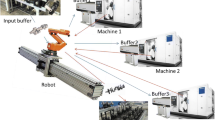Abstract
In this paper, a mathematical model and a solution algorithm are developed for solving a robot acquisition and cell formation problem (RACFP). Our model considers purchasing a proper mix of robots and assigning all given workstations to purchased robots such that each robot cell satisfies its workstations' resource demands while minimizing the total system (acquisition) cost. Specifically, each robot has two capacity constraints - available work envelope and effective machine time. RACFP is formulated as a multi-type two-dimensional bin packing problem, a pure 0-1 integer program which is known to be NP-hard. In this paper, a very efficient (polynomial time bound) heuristic algorithm is developed and implemented. The algorithm consists of two major stages. The first stage employs an LP-based bounding procedure to produce a tight solution bound, whereas the second stage repetitively invokes a random search heuristic using a greedy evaluation function. The algorithm is tested by solving 450 randomly generated problems based on realistic parameter values. Computational results show that the heuristic algorithm has outperformed algorithms using general optimization techniques such as Simulated Annealing and Column Generation. All test problems are solved within an order of magnitude of 10 seconds, with a gap of less than 1% from the optimum. More importantly, over 70% of all solutions are optimal (334 out of 450). The algorithm can be easily modified for other applications such as file placement for a multi-device storage system and job scheduling for a multi-processing system.
Similar content being viewed by others
References
E.H.L. Aarts and P.J.M. Van Laarhoven, Statistical cooling: A general approach to combinatorial problems, Phillips Journal of Research 40(1985)193 - 226.
E. Appleton and D.J. Williams, Industrial Robot Applications, Wiley, New York, 1987, Chapter 3.
J.F. Bard and T.A. Feo, An algorithm for the manufacturing equipment selection problem, IIE Transactions 23(1991)83 - 92.
W.T. Baumol and Y.M. Braunstein, Empirical study of scale economies and production complementarity: The case of journal productions, Journal of Political Economy 85(1987)1037 - 1048.
O. Berman and O. Maimon, Cooperation among flexible manufacturing systems, IEEE Journal of Robotics and Automation RA-2(1986)24 - 30.
R. Bernhardt, R. Dillman, K. Hormann and K. Tierney, Integration of Robots into CIM, Chapman and Hall, London, UK, 1992.
J. Blazewicz, M. Drabowski and J. Welgarz, Scheduling multiprocessor tasks to minimize schedule length, IEEE Transactions on Computers C-35(1986)389 - 393.
T.C. Chang, R. Wysk and H.P. Wang, Computer-Aided Manufacturing, Prentice-Hall, Englewood Cliffs, NJ, 1991, Chapters 9 and 14.
E.G. Coffman, M.R. Garey and D.S. Johnson, Approximation algorithms for bin-packing - an updated survey, in: Algorithm Design for Computer System Design, G. Ausiello, M. Luccertini and P. Serafini, eds., Springer, Vienna, 1984, pp. 49 - 106.
J.S. Cook and B.T. Han, Optimal robot selection and workstation assignment for a CIM system, IEEE Transactions on Robotics and Automation 10(1994)210 - 219.
P.C. Gilmore and R.E. Gomory, A linear programming approach to the cutting-stock problem, Operations Research 9(1961)849 - 859.
B.T. Han, G. Diehr and J.S. Cook, Multiple-type, two-dimensional bin packing problems: Applications and algorithms, Annals of Operations Research 50(1994)239 - 261.
B.T. Han and J.S. Cook, Optimal robot acquisition for multiple cell formation, Working Paper, Department of Management and Systems, Washington State University, 1996.
S.S. Heragu, Recent models and techniques for the facility layout problem, European Journal of Operational Research 57(1992)136 - 144.
S.S. Heragu and C.M. Lucarelli, Automated manufacturing system design using analytical techniques, in: The Industrial Electronics Handbook, J.D. Irwin, ed., CRC Press, Boca Raton, FL, 1996.
V.D. Hunt, Computer Integrated Manufacturing Handbook, Chapman and Hall, London, UK, 1989.
W.D. Jeng, J.T. Lin and U.P. Wen, Algorithms for sequencing robot activities in a robot-centered parallel-processor workcell, Computers and Operations Research 20(1993)185-197.
S.B. Joshi, E.G. Mettala, J.S. Smith and R.A. Wysk, Formal models for control of flexible manufacturing cells: Physical and system model, IEEE Transactions on Robotics and Automation 11 (1995)558- 570.
J. Kimemia and S.B. Gershwin, An algorithm for the computer control of a flexible manufacturing system, IIE Transactions 15(1983)353 - 362.
A. Kusiak, The production equipment requirements problem, International Journal of Production Research 25(1987)319 - 325.
E. Lee and P.B. Mirchandani, Concurrent routing, sequencing, and setups for a two-machine flexible manufacturing cell, IEEE Journal of Robotics and Automation RA-4(1988)256 - 264.
R. Maus and R. Allsup, Robotics: A Manager's Guide, Wiley, New York, 1986.
G.J. Miltenburg and I. Krinsky, Evaluating flexible manufacturing systems, IIE Transactions 19 (1987)222 - 233.
L.R. Nyman (ed.), Making Manufacturing Cells Work, Society of Manufacturing Engineers with Computers and Automated Systems Association, McGraw Hill, New York, 1992.
J.C. Panzar and R.D. Willig, Economies of scope, Papers and Proceedings of the 93rd Annual Meeting of the American Economic Association, American Economic Review 71(1981)268 - 272.
S.C. Sarin and W.E. Wilhelm, Prototype models for two-dimensional layout design of robot systems, IIE Transactions 16(1984)206 - 215.
K.E. Stecke, Formulation and solution of nonlinear integer production planning problems for flexible manufacturing systems, Management Science 29(1983)273 - 288.
W.E. Wilhelm, An approach for modeling transient material flows in robotised manufacturing cells, Material Flow 3(1986)55 - 68.
Rights and permissions
About this article
Cite this article
Han, B.T., Cook, J.S. An efficient heuristic for robot acquisition and cell formation. Annals of Operations Research 77, 229–252 (1998). https://doi.org/10.1023/A:1018977428236
Issue Date:
DOI: https://doi.org/10.1023/A:1018977428236




